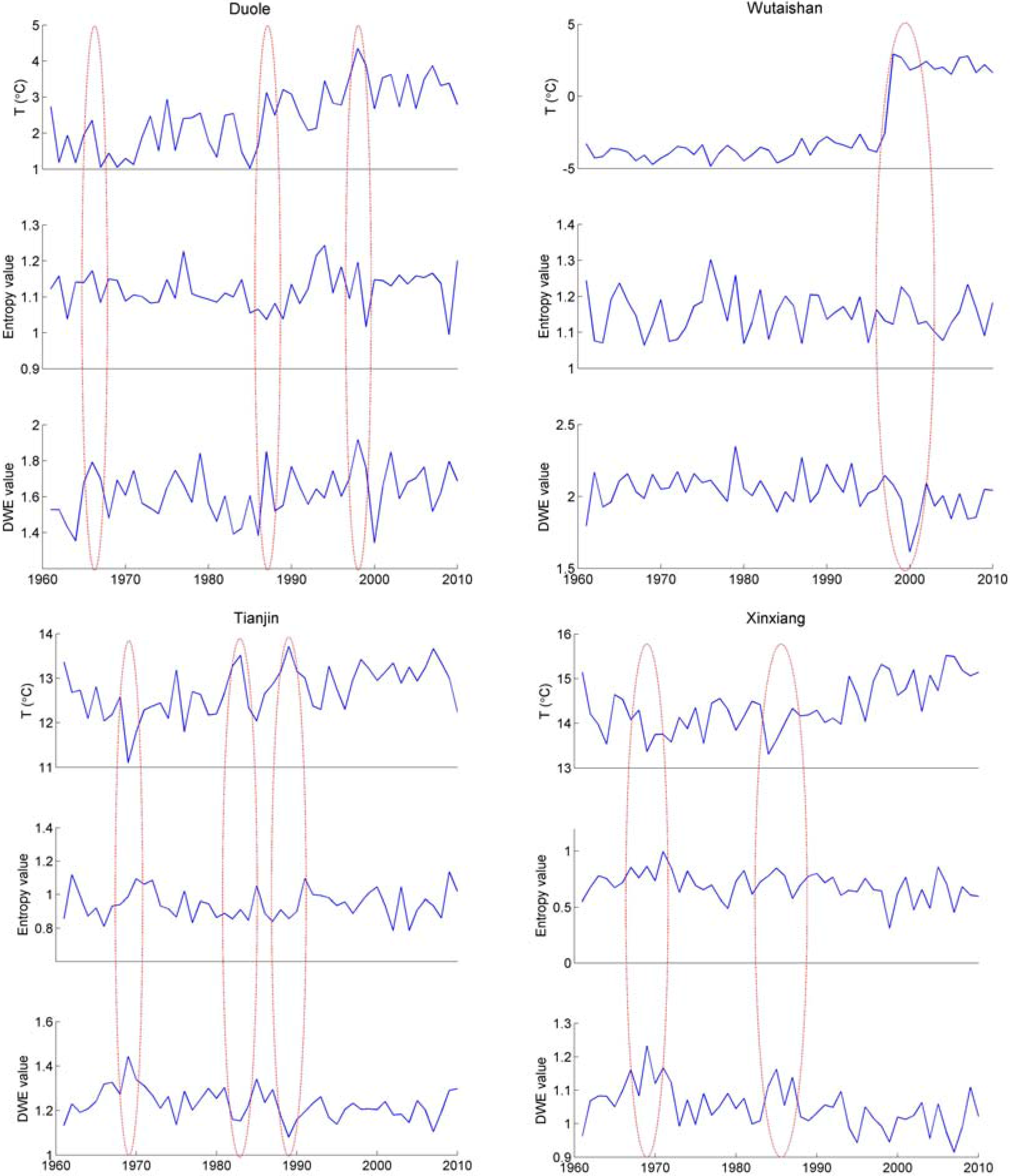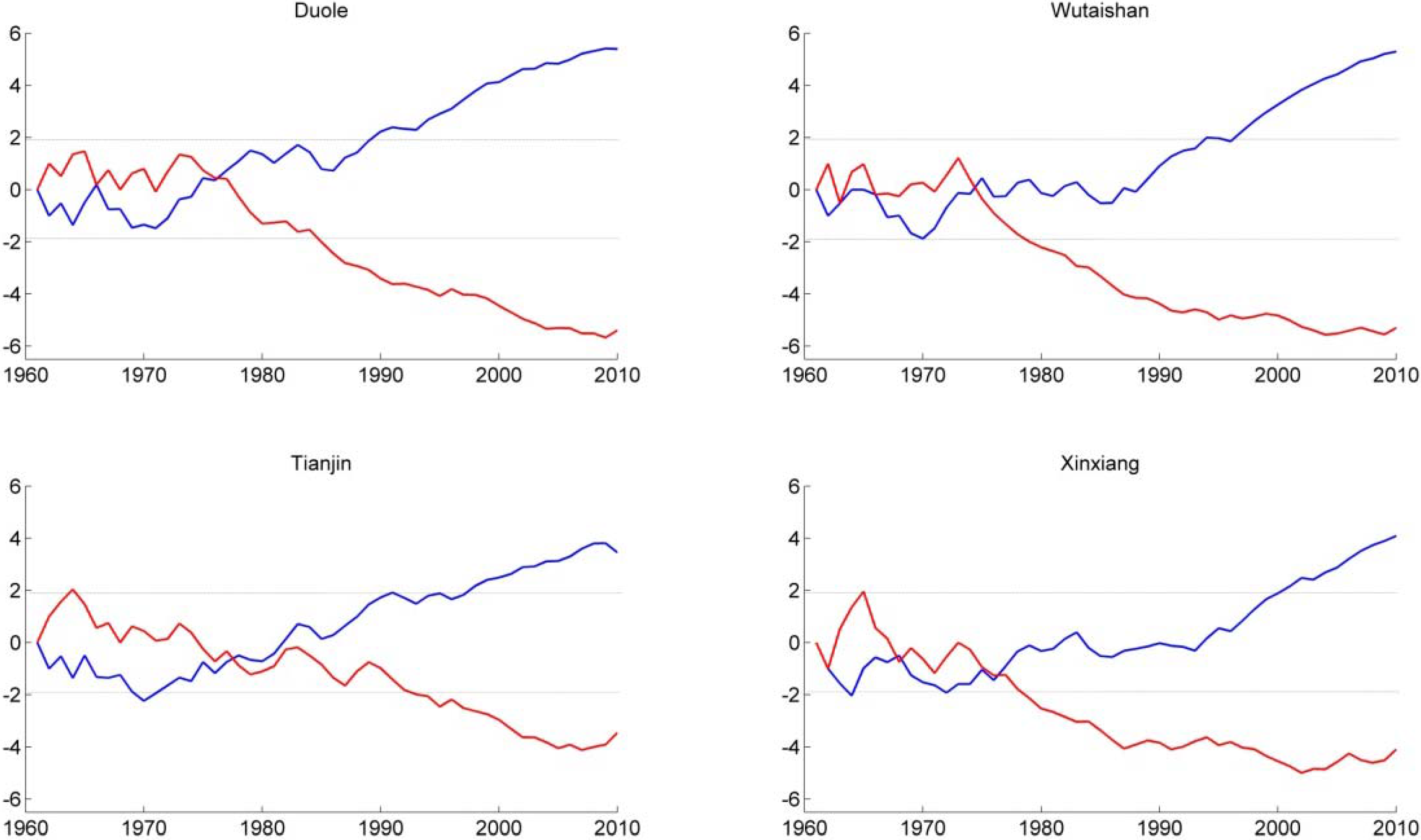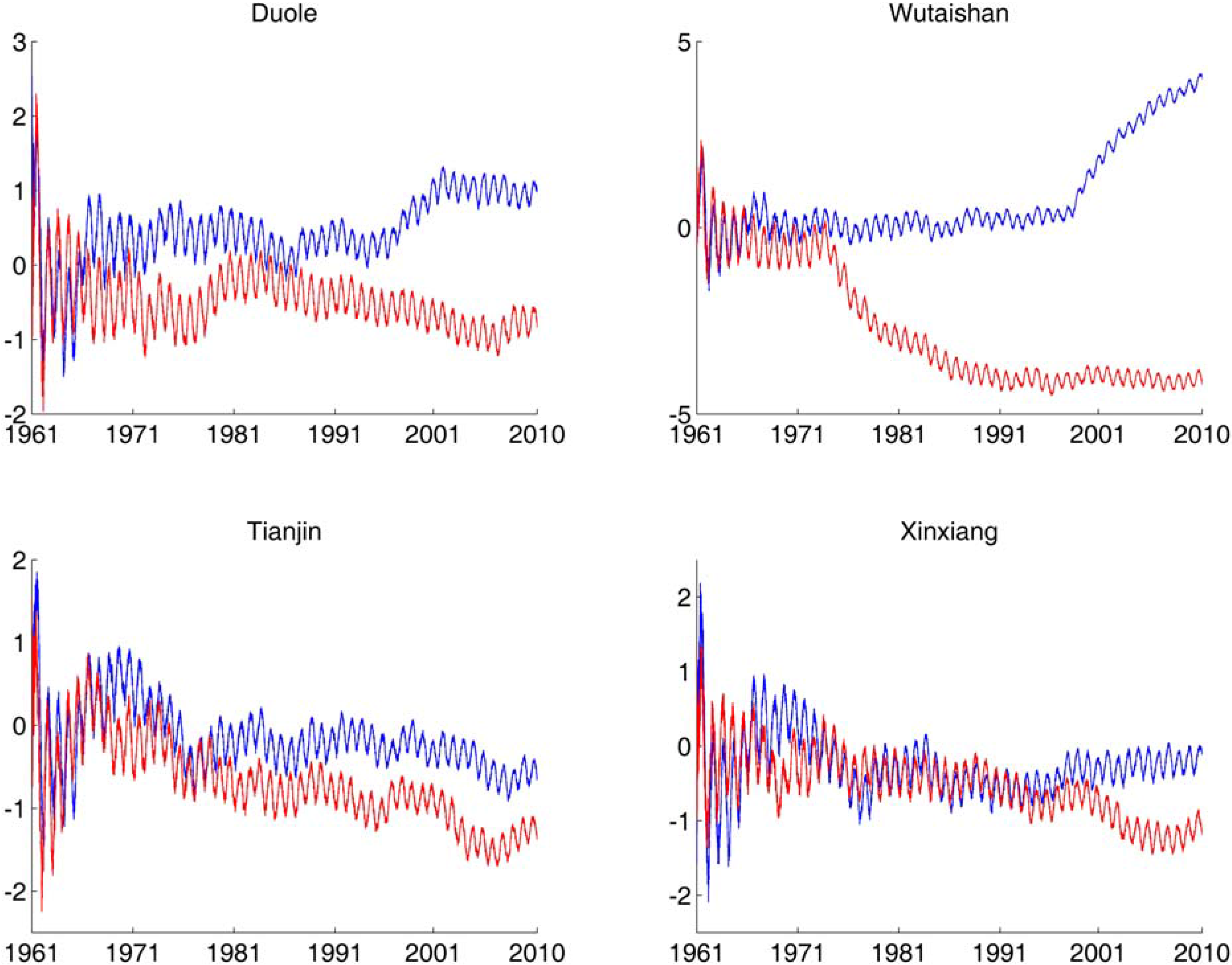Discrete Wavelet Entropy Aided Detection of Abrupt Change: A Case Study in the Haihe River Basin, China
Abstract
:1. Introduction
2. Data Set and Methods
2.1. Data Set


2.2. MK Test
2.3. The DWE-Aided Approach Proposed
3. Results and Discussion


4. Conclusions
Acknowledgements
References
- Loukas, A.; Vasiliades, L.; Dalezios, N.R. Potential climate change impacts on flood producing mechanisms in southern British Columbia, Canada using the CGCMA1 simulation results. J. Hydrol. 2002, 259, 163–188. [Google Scholar] [CrossRef]
- Camilloni, I.A.; Barros, V.R. Extreme discharge events in the Parana River and their climate forcing. J. Hydrol. 2003, 278, 94–106. [Google Scholar] [CrossRef]
- Clark, P.U.; Alley, R.B.; Pollard, D. Northern hemisphere ice-sheet influences on global climate change. Science 1999, 286, 1104–1111. [Google Scholar] [CrossRef]
- Labat, D.; Godderis, Y.; Probst, J.L.; Guyot, J.L. Evidence for global runoff increase related to climate warming. Adv. Water Resour. 2004, 27, 631–642. [Google Scholar] [CrossRef] [Green Version]
- Douglas, E.M.; Vogel, R.M.; Kroll, C.N. Trends in floods and low flows in the United States: Impact of spatial correlation. J. Hydrol. 2000, 240, 90–105. [Google Scholar] [CrossRef]
- Brunetti, M.; Maugeri, M.; Monti, F.; Nanni, T. Temperature, precipitation variability in Italy in the last two centuries from homogeneised instrumental time series. Inter. J. Climatol. 2006, 26, 345–381. [Google Scholar] [CrossRef]
- Sang, Y.F.; Wang, Z.G.; Li, Z.L.; Liu, C.M.; Liu, X.J. Investigation into the daily precipitation variability in the Yangtze River Delta, China. Hydrol. Process. 2012. [Google Scholar] [CrossRef]
- Mishra, A.K.; Ozger, M.; Singh, V.P. An entropy-based investigation into the variability of precipitation. J. Hydrol. 2009, 370, 139–154. [Google Scholar] [CrossRef]
- Milly, P.C.D.; Wetherald, R.T.; Dunne, K.A.; Delworth, T.L. Increasing risk of great floods in a changing climate. Nature 2002, 415, 514–517. [Google Scholar] [CrossRef] [PubMed]
- Sang, Y.F.; Wang, D.; Wu, J.C. Probabilistic forecast and uncertainty assessment of hydrologic design values using Bayesian theories. Hum. Ecol. Risk Assess. 2010, 16, 1184–1207. [Google Scholar] [CrossRef]
- Li, Z.W.; Zhang, Y.K. Multi-scale entropy analysis of Mississippi river flow. Stoch. Env. Res. Risk A. 2008, 22, 507–512. [Google Scholar] [CrossRef]
- Xia, J.; Liu, C.M.; Ding, Y.J.; Jia, S.F.; Lin, C.H. China Water Resources Vision; The Press of Science: Beijing, China, 2011; Volume 1. [Google Scholar]
- Kendall, M. Rank Correlation Methods; Charles Griffin: London, UK, 1975. [Google Scholar]
- Mann, H. Non-parametric tests against trend. Econometrica 1945, 13, 245–259. [Google Scholar] [CrossRef]
- Kuczera, G. Uncorrelated measurement error in flood frequency inference. Water Resour. Res. 1992, 28, 183–188. [Google Scholar] [CrossRef]
- Mann, M.E.; Lees, J.M. Robust estimation of background noise and signal detection in climatic time series. Clim. Change 1996, 33, 409–445. [Google Scholar] [CrossRef]
- Kundzewicz, Z.W.; Graczyk, D.; Maurer, T.; Pinskwar, I.; Radziejewski, M.; Svensson, C.; Szwed, M. Trend detection in river flow series: 1. Annual maximum flow. Hydrol. Sci. J. 2005, 50, 797–810. [Google Scholar] [CrossRef]
- Shao, Q.X.; Li, M. A new trend analysis for seasonal time series with consideration of data dependence. J. Hydrol. 2011, 396, 104–112. [Google Scholar] [CrossRef]
- Sang, Y.F.; Wang, Z.G.; Liu, C.M. Discrete wavelet-based trend identification in hydrologic time series. Hydrol. Process. 2012. [Google Scholar] [CrossRef]
- Adamowski, K.; Prokoph, A.; Adamowski, J. Development of a new method of wavelet aided trend detection and estimation. Hydrol. Process. 2009, 23, 2686–2696. [Google Scholar] [CrossRef]
- Hamed, K.H. Trend detection in hydrologic data: The Mann-Kendall trend test under the scaling hypothesis. J. Hydrol. 2008, 349, 350–363. [Google Scholar] [CrossRef]
- Khaliq, M.N.; Ouarda, T.B.M.J.; Gachon, P.; Sushama, L.; St-Hilaire, A. Identification of hydrological trends in the presence of serial and cross correlations: A review of selected methods and their application to annual flow regimes of Canadian rivers. J. Hydrol. 2009, 368, 117–130. [Google Scholar] [CrossRef]
- Rivard, C.; Vigneault, H. Trend detection in hydrological series: When series are negatively correlated. Hydrol. Process. 2009, 23, 2737–2743. [Google Scholar] [CrossRef]
- Zaccarelli, N.; Li, B.L.; Petrosillo, I.; Zurlini, G. Order and disorder in ecological time-series: Introducing normalized spectral entropy. Ecol. Indic. 2011. [Google Scholar] [CrossRef]
- Ren, W.X.; Sun, Z.S. Structural damage identification by using wavelet entropy. Eng. Struct. 2008, 30, 2840–2849. [Google Scholar] [CrossRef]
- Rosso, O.A.; Blanco, S.; Yordanova, J.; Kolev, V.; Figliola, A.; Schurmann, M.; Basar, E. Wavelet entropy: A new tool for analysis of short duration brain electrical signals. J. Neurosci. Meth. 2001, 105, 65–75. [Google Scholar] [CrossRef]
- Zhang, Y.C. Complexity and 1/f noise: A phase space approach. J. Phys. I France 1991, 1, 971–977. [Google Scholar] [CrossRef]
- Costa, M.; Goldberger, A.L.; Peng, C.K. Multiscale entropy analysis of biological signals. Phys. Rev. E 2005, 71, 021906. [Google Scholar] [CrossRef]
- Percival, D.B.; Walden, A.T. Wavelet Methods for Time Series Analysis; Cambridge University Press: Cambridge, UK, 2000. [Google Scholar]
- Chui, C.K. Wavelet Analysis and Its Applications. In An Introduction to Wavelets; Academic Press: Boston, MA, USA, 1992. [Google Scholar]
- Sang, Y.F. A practical guide to discrete wavelet decomposition of hydrologic time series. Water Resour. Manag. 2012. [Google Scholar] [CrossRef]
- Zunino, L.; Perez, D.G.; Garavaglia, M.; Rosso, O.A. Wavelet entropy of stochastic processes. Phys.A Stat. Mech. Appl. 2007, 379, 503–512. [Google Scholar] [CrossRef]
- Emre Cek, M.; Ozgoren, M.; Acar Savaci, F. Continuous time wavelet entropy of auditory evoked potentials. Comput. Biol. Med. 2010, 40, 90–96. [Google Scholar] [CrossRef] [PubMed]
- Jaynes, E.T. Information theory and statistical mechanics. Phys. Rev. 1957, 106, 620–630. [Google Scholar] [CrossRef]
- Brunsell, N.A. A multiscale information theory approach to assess spatial-temporal variability of daily precipitation. J. Hydrol. 2010, 385, 165–172. [Google Scholar] [CrossRef]
- Chou, C.M. Wavelet-Based Multi-Scale Entropy Analysis of Complex Rainfall Time Series. Entropy 2011, 13, 241–253. [Google Scholar] [CrossRef]
- Mishra, A.K.; Özger, M.; Singh, V.P. An entropy-based investigation into the variability of precipitation. J. Hydrol. 2009, 370, 139–154. [Google Scholar] [CrossRef]
- Wang, Z.; Luo, Y.; Liu, C.; Xia, J.; Zhang, M. Spatial and temporal variations of precipitation in Haihe River Basin, China: Six decades of measurements. Hydrol. Process. 2011, 25, 2916–2923. [Google Scholar] [CrossRef]
- Khaliq, M.N.; Ouarda, T.B.M.J.; Gachon, P.; Sushama, L.; St-Hilaire, A. Identification of hydrological trends in the presence of serial and cross correlations: A review of selected methods and their application to annual flow regimes of Canadian rivers. J. Hydrol. 2009, 368, 117–130. [Google Scholar] [CrossRef]
- Singh, V.P. Entropy-Based Parameter Estimation in Hydrology; Kluwer Academic Publishers: Boston, MA, USA, 1998. [Google Scholar]
- Sang, Y.F. Wavelet entropy-based investigation into the daily precipitation variability in the Yangtze River Delta with rapid urbanization. Theor. Appl. Climatol. 2012. [Google Scholar] [CrossRef]
- Sang, Y.F.; Wang, D.; Wu, J.C.; Zhu, Q.P.; Wang, L. Wavelet-based analysis on the complexity of hydrologic series data under multi-temporal scales. Entropy 2011, 13, 195–210. [Google Scholar] [CrossRef]
© 2012 by the authors; licensee MDPI, Basel, Switzerland. This article is an open access article distributed under the terms and conditions of the Creative Commons Attribution license (http://creativecommons.org/licenses/by/3.0/).
Share and Cite
Sang, Y.-F.; Wang, Z.-G.; Li, Z.-L. Discrete Wavelet Entropy Aided Detection of Abrupt Change: A Case Study in the Haihe River Basin, China. Entropy 2012, 14, 1274-1284. https://doi.org/10.3390/e14071274
Sang Y-F, Wang Z-G, Li Z-L. Discrete Wavelet Entropy Aided Detection of Abrupt Change: A Case Study in the Haihe River Basin, China. Entropy. 2012; 14(7):1274-1284. https://doi.org/10.3390/e14071274
Chicago/Turabian StyleSang, Yan-Fang, Zhong-Gen Wang, and Zong-Li Li. 2012. "Discrete Wavelet Entropy Aided Detection of Abrupt Change: A Case Study in the Haihe River Basin, China" Entropy 14, no. 7: 1274-1284. https://doi.org/10.3390/e14071274




